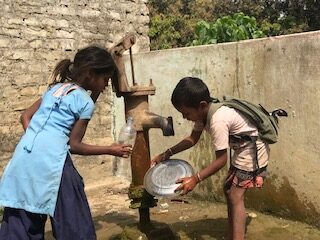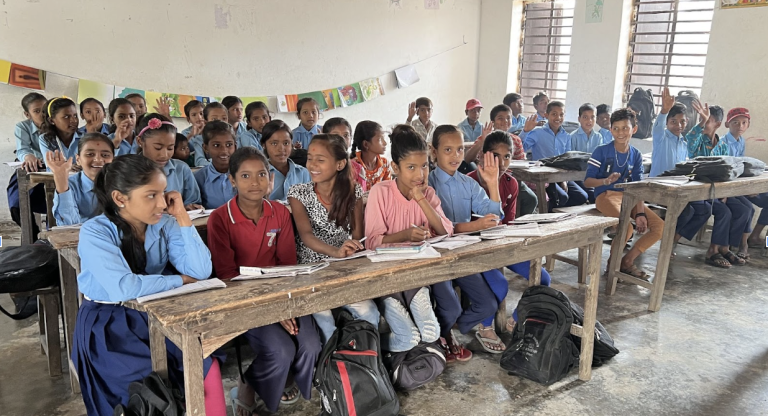Authors: Regina Rajbanshi, and Shreda Shrestha
Date: 8th of Dec, 2022.
When it comes to discerning the root causes of gender-inequality in any given society, gender biases and prejudices that find confirmations and reinforcements within the periphery of homes also spread out and influence other dimensions of society. However, when schools provide an exemplary environment that encourages students to participate in different classroom activities, make school resources equally available to both girls and boys, create a safe teaching and learning space, and impart respect and recognize student’s achievements irrespective of their gender, the schools also become a platform for fostering a sense of gender equality among students. With this as a pretext, this blog article explores and analyzes the situation of gender equality in the community schools of Yamunamai Rural Municipality of the Rautahat district. Here, the indicators for analyzing gender equality include the number of boys and girls in classrooms, as well as the availability of equal opportunities and capability enhancement initiations that lead to equal participation and accomplishments.
For examining and exploring gender equality in community schools, this study has been initiated with following exploration questions: How community schools in rural areas support gender equality? Are girls and boys in community schools experiencing discrimination based solely on their gender? Can both girls and boys participate equally in school activities? What is the perception of girls and boys towards a sense of the same respect they receive in these schools? And to find answers to these pertinent concerns, girls and boys of grades 4–8 from 8 different rural community schools in the Yamunamai rural municipality of the Rautahat district were interviewed to collect the responses regarding these questions. During the study, a total of 230 (N=230) girls and boys as respondents were interviewed. Among sampled respondents 116 of them were girls and 114 of them were boys. Moreover, this study is a part of the research project ” Effectiveness and Scalability of Programs for Children who are Out of School and at Risk of Dropping Out in Bangladesh, Bhutan, and Nepal,” where various aspects and indicators such as participation, resources, bodily integrity and respect are analyzed to examine and explore gender (in)/equality in the schools of the rural municipality.
This blog article has been divided into two parts. The first part encompasses of participation and the availability of resources in relation to gender (in) equality.
Part I
PARTICIPATION
“Whenever I don’t understand any topics, I raise my hand and ask the teacher to explain the topic once again. She further says, “It is not a new habit for me to raise my hand in the class, I feel confident to raise my hand whenever feel the need to ask a question or inquire further regarding the topic – Karina
Regarding participation, like Karina, the majority of the students involved in this study indicate that their teachers encourage equal participation of both girls and boys in the question-and-answer sessions and they also frequently take part in and control class discussions. As students indicate they are also encouraged to volunteer their participation in different classroom projects, and more importantly girls in particular do not hesitate to raise their hands when responding or posing questions. Besides, the students confidently express that their teachers aren’t engaged in any discriminatory practices toward them, such as interrupting student responses or forbidding female students from responding or posing questions.
Beyond the classroom involvement, this study has also observed the participation of girls and boys in the outdoor games played in their respective schools. Due to stereotypical gender roles prevalent in society, it has commonly been assumed that schools create gender stereotypes by allowing boys to participate in outdoor games and pushing girl students to participate more in indoor games. However, this is not the case in rural community schools of Yamunamai rural municipality. As indicated by respondents 73.7 percent of them feel that they are included in outdoor sports and other training activities of schools. The ratio of girls included in outdoor games was higher than boys. Hence, from the contextual observation, it was evident that the equal participation among both girl and boys students was encouraged in the community schools of the rural municipality and the equitable participation was not limited to the classroom but beyond as well.
RESOURCES
Multiple studies iterate that availability of resources is an important factor that encourages students to attend school. Here, one such resource that illustrates the importance of availability of resources is the provision of WASH facilities, which includes the availability of separate toilets for girls and boys and this facility is not just limited to hygiene but it also affects the overall retention rate of the students, mainly of girls. To emphasize further, one of the biggest obstacles to girls’ education is the absence of WASH facilities.
While examining crucial resources such as toilet facilities, this study observes that most of the rural community schools have separate toilets for girls and boys. According to 78.7 percent of students, their respective schools have separate toilets. Likewise, the students were aware that WASH facilities are extremely important for them. The study indicates that 36.53 percent of the girls were satisfied with the availability of separate toilets followed by 32.17 percent boys. Furthermore, the students have also elaborated that the amenities inside the toilets are not in proper condition and it required maintenance. Basic amenities for toilets include dustbins for disposing of sanitary pads, soap, and clean water for flushing. Despite the absence of aforementioned amenities, the basic construction of separate toilets has made changing of sanitary pads among girls easier and embarrassment-free and the availability of this resource has encouraged the girls to attend schools even during their periods.
Part II
Part I of this blog article focused on the teaching and learning practices of educators that have actively encouraged both girl and boy students to participate in class discussions, Q&A sessions, and other classroom activities as well as in sports. Part I has also highlighted the importance of providing basic amenities such as restrooms to students and how important it is for students, particularly girls, to feel comfortable using them. However, in order for students to fully benefit from these provisions, schools need to first provide a safe environment and inculcate the habit of respecting students and recognizing their achievements irrespective of their gender differences. Therefore, Part II of this blog examines and explores gender (in) equality from the lens of bodily integrity and respect.
For exploring gender (in) equality from these two indicators, different questions were formulated such as: Are girls afraid to go to school or feel unsafe walking around in the school premises? Has anyone been subjected to any form of violence or harassment within the school premises? Have girl students received uncomfortable gestures from male teachers, female teachers or from their friends? These questions were asked to gather information on body integrity. Similarly, in order to observe gender equality from the perspective of respect, the questions asked to elicit data were as follows: Do teachers respect their students irrespective of their gender? Do teachers greet their students? Have the achievements of students been recognized by teachers?
BODILY INTEGRITY
When women are denied the right to make decisions about their bodies, they are compelled to live in a psycho-social condition of constant fear, physical assault, and are also subjected to discrimination and exploitation. It is an inherent right of women to be in charge of and have utmost autonomy over their bodies and this component is an integral part of their bodily integrity. A sense of bodily integrity includes the right to: a life free from fear of violence and living in safe environments. Hence, within this conceptualization of bodily integrity, this study has tried to explore whether community schools are safe spaces for students.
Regarding bodily integrity, 66.09 percent of the students interviewed felt completely safe walking around in their school premises. Both genders have acknowledged a sense of security within their schools. Importantly, there is no sense of fear among girls students when it comes to going to their schools, and neither have they ever noticed or felt uncomfortable gestures from the male teachers or male friends. Besides, the students have not felt been subjected to any types of violence, harassment, or bullying from their fellow students. From the response of students this study indicates towards an impression that schools are a secure environment where there is no condition as such for girls to feel weak and vulnerable due to their gender.
RESPECT
Respect is maintained mutually among teachers and students. More often than not, children learn from their environment, therefore the feeling of being respected and acknowledged becomes an integral part of an effective and equitable teaching and learning environment. Hence, an educator needs to consistently exhibit respect. Moreover, a teacher’s authority becomes a natural barrier that impedes student learning when they refuse to show respect towards their students. In a setting where the teacher’s sense of respect to students exceeds their authority, students’ participation towards different dimensions of teaching and learning activities also enhances.
Concerning this indicator, in the community schools of the Yamunamai rural municipality, 67.39% of the students strongly agreed that their teachers respect them irrespective of their gender and other social backgrounds and this sense of respect is also reciprocal. In addition, both girls and boys in the school haven’t experienced discrimination on the basis of their gender. When the students were asked if they feel respected in their schools irrespective of their gender, 52.35 percent girls and 47.64 percent boys indicated their experience as affirmative. Similarly, teachers greeting back to their students is another way of analyzing respect and gender equality in the schools. When teachers greet the students back, this response creates an assured school environment in which students feel a sense of connection and belonging. Likewise, according to 88.7 percent of respondents, the teachers greeted them all the time. This positive response has created an inclusive affirmation among students as they sense being valued by their teachers.
Furthermore, in this study, gender (in) equality has been analyzed with the help of GESI (Gender, Equality and Social Inclusion) framework using indicators such as participation, resources, bodily integrity and respect, which has enabled this study to generate evidence that indicates a significant progress has been achieved when it comes to promoting equality among girl and boy students at the community schools of the Yamunamai rural municipality of Rautahat district. Besides, the media outreach, the strategies of various INGOs/NGOs, policies of local and federal government, research and development initiatives have all contributed towards the successful attempts necessary to address gender equality, notably in rural areas and rural community schools.





